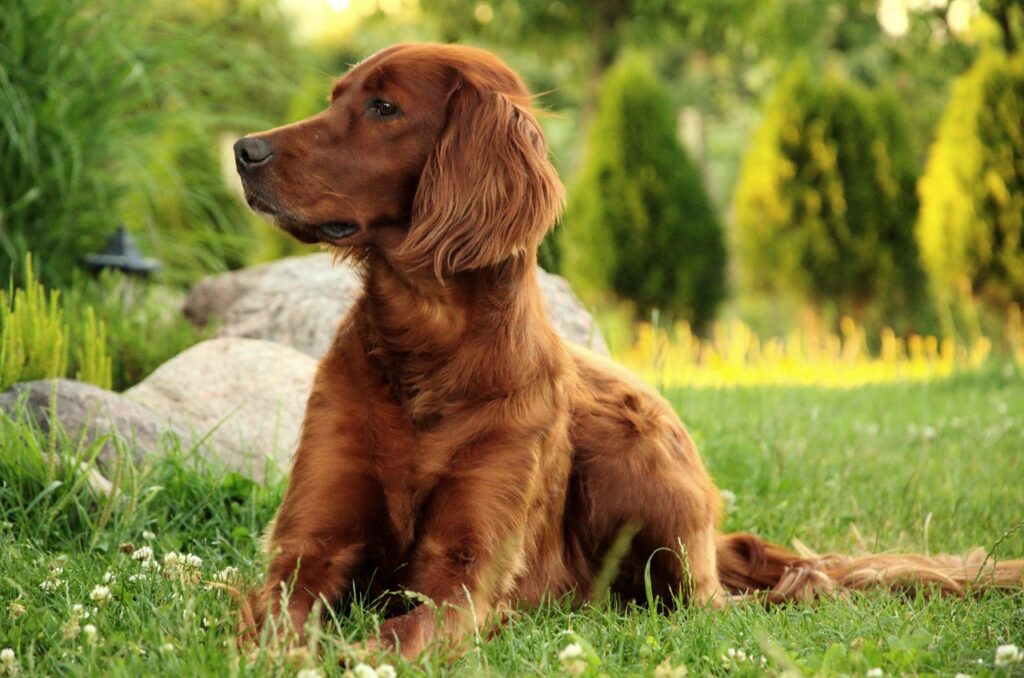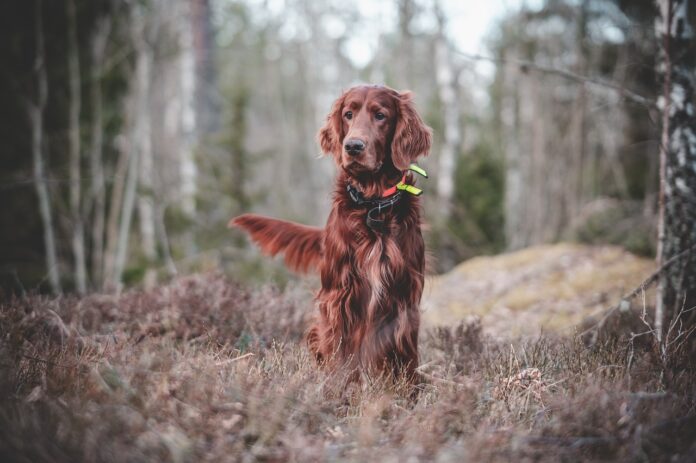The Irish Red Setter ranks as one of the most visually striking dog breeds worldwide. This dog captures attention everywhere due to its flowing mahogany coat and graceful build.
Every potential owner should understand its rich history, complex personality, and specific care requirements beyond its stunning appearance.
Origins and History of the Irish Red Setter
The Irish Red Setter story began in Ireland during the early 18th century. Irish hunters needed dogs with exceptional scenting abilities to locate game birds across varied Irish terrain.
The original setters came from crosses between spaniels, pointers, and other hunting breeds.
Early Irish Setters showed both red and white coloration. These dogs earned their name from their distinctive hunting style.
They would “set” or freeze after locating birds. This allowed hunters to cast nets over the prey. The setter’s role evolved to point out game locations as firearms replaced nets.
Selective breeding in the 1800s created the solid red coat we recognize today. The Earl of Enniskillen played a key role in the red variety’s development and promotion.
The first breed standard appeared in 1886. Irish Red Setters soon gained popularity beyond Ireland’s shores.
The breed reached America in the late 19th century. The American Kennel Club officially recognized it in 1878.
A split occurred in breeding practices afterward. American breeders favored dogs with deeper red coats and larger builds. Irish breeders maintained focus on field performance.
Physical Characteristics
The Irish Red Setter displays unmistakable elegance. Adult males stand 25-27 inches tall at the shoulder.
Females measure 23-25 inches. Male weight typically ranges from 60-70 pounds. Females weigh about 55-65 pounds.
The beautiful coat serves a practical purpose. It protects against thorny underbrush and harsh weather conditions.
Their heads look long and lean with a pronounced stop. Dark brown or hazel eyes convey intelligence and sweetness.
Long, silky ears set low on the head frame the face. The muzzle appears square and deep with a black or dark brown nose.
The body structure shows athletic proportions. A deep chest, straight back, and powerful hindquarters stand out.
The tail carries straight, nearly level with the back. The entire package creates a dog that moves with grace and power.
Temperament and Personality Traits
Irish Red Setters exhibit affectionate, outgoing personalities. They form strong bonds with their families.
These dogs often show particular fondness for children. Social by nature, they typically get along well with other dogs and pets. This happens especially when they grow up together.
These dogs keep a youthful spirit well into adulthood. Their playful nature sometimes creates training challenges.
Their enthusiasm can override focus. They possess considerable intelligence despite this trait. Patient, consistent training brings out their natural desire to please.
The breed shows remarkable energy levels. This reflects their hunting heritage, which required stamina for long field days.
They may develop behavioral issues without proper energy outlets. Problems can include excessive barking or destructive chewing.
Irish Red Setters respond to their owners’ emotions. They thrive with positive reinforcement.
Harsh correction methods cause them to struggle. Their gentle nature makes them poor guard dogs. They tend to see strangers as potential new friends.

Health Considerations for Irish Red Setters
Irish Red Setters live 12 to 15 years on average. They face certain breed-specific health challenges owners should monitor, like all purebred dogs.
Hip dysplasia affects many large breeds, including Irish Setters. This condition happens when the hip joint forms improperly. It leads to arthritis and mobility issues.
Progressive Retinal Atrophy (PRA) presents another concern. This inherited eye disorder causes gradual retina deterioration.
It potentially leads to blindness. Genetic tests help identify carriers of this condition.
Gastric Dilatation-Volvulus (GDV), commonly called bloat, poses a serious emergency risk.
This condition occurs when the stomach fills with gas and twists. It cuts off blood supply. Large, deep-chested breeds like Irish Setters show particular vulnerability.
Epilepsy appears in some Irish Setter lines. It causes seizures that require management with medication.
Hypothyroidism also affects the breed. It creates symptoms like weight gain, lethargy, and coat problems when the thyroid gland produces insufficient hormones.
Responsible breeding practices help reduce these risks. Practices include genetic testing and health clearances.
Regular veterinary checkups enable early detection and intervention for many conditions.
Nutritional Needs
Irish Red Setters need high-quality dog food. The food should match their size, age, and activity level.
Active adult Irish Setters typically need 2-3 cups of premium dry food daily. This amount works best when divided into two meals.
Individual needs vary based on metabolism, exercise levels, and other factors.
These dogs sometimes eat too quickly. This habit increases bloat risk. Slow-feed bowls or puzzle feeders help address this tendency.
Proper weight maintenance proves essential. Extra pounds stress joints and overall health.
The breed occasionally develops food allergies or sensitivities. Signs include chronic ear infections, excessive scratching, or digestive upset.
Elimination diets help identify problem ingredients when necessary.
Clean, fresh water must remain available at all times. This becomes particularly important during exercise sessions. Active dogs need proper hydration.
Exercise Requirements
The Irish Red Setter needs substantial daily exercise. This maintains physical and mental health.
These dogs evolved for endurance hunting. This created high energy requirements. Most Irish Setters need 60-90 minutes of activity daily.
Variety enriches their exercise routine. Long walks provide a baseline. These athletic dogs enjoy runs in secure areas.
Many excel at activities like jogging, hiking, and swimming. Dog sports offer excellent outlets for their natural abilities. Options include agility, flyball, obedience trials, and field trials.
Mental stimulation matters as much as physical exercise. Training sessions, puzzle toys, and scent games engage their bright minds.
These intelligent dogs find their own entertainment without adequate mental challenges. This often leads to destructive behavior.
Young Irish Setters need controlled exercise until their growth plates close. This typically happens around 18-24 months. Excessive high-impact activity during development increases orthopedic injury risks.
Training and Socialization
Irish Red Setters respond best to positive reinforcement training methods. Their sensitive nature means harsh corrections often backfire.
This can create anxiety or avoidance behaviors. Rewards like treats, praise, and play motivate them effectively.
Consistency provides the foundation for successful training. These dogs detect inconsistency quickly.
They exploit gaps in rules. Short, engaging sessions work better than lengthy drills. Their attention span can waver.
Early socialization shapes a well-adjusted adult dog. Exposure to various people, animals, environments, and situations helps.
This matters most during the critical puppy period (before 16 weeks). It builds confidence. Continued socialization throughout adolescence reinforces these early lessons.
House training requires patience. Some Irish Setters take longer than other breeds to develop reliable habits.
Crate training offers an effective approach. It uses their natural desire to keep their sleeping area clean.
The breed shows particular aptitude for advanced training related to their hunting heritage. Many excel in tracking, field trials, and scent work. These activities provide ideal outlets for their natural abilities.
Grooming Requirements
The beautiful Irish Red Setter coat demands regular attention. Weekly brushing prevents tangles and removes loose hair. Daily brushing helps manage increased hair loss during seasonal shedding periods.
The feathering on legs, tail, ears, and chest requires special attention to prevent mats. A slicker brush works well for general coat care. A metal comb tackles feathered areas effectively.
Bathing every 4-6 weeks maintains coat health without removing essential oils. Spot cleaning addresses mud or debris between baths.
Professional grooming every few months helps maintain the coat’s characteristic appearance.
Ears need weekly checks and cleaning to prevent infection. Their pendulous shape limits air circulation.
This creates an environment where bacteria and yeast thrive. Gentle cleaning with a veterinarian-approved solution prevents problems.
Nail trimming every 3-4 weeks prevents overgrowth. Long nails affect gait and comfort. Regular tooth brushing with dog-specific toothpaste supports dental health. It prevents periodontal disease.
Living with an Irish Red Setter
Irish Red Setters adapt well to various living situations. Their exercise needs must receive proper attention.
They prefer homes with secure, fenced yards. This allows them to run safely. Their hunting background means they may chase small animals. Reliable recall training becomes essential before off-leash activities.
These dogs form strong bonds with family members. They suffer from separation anxiety when left alone too much.
They thrive in homes where someone stays present most of the day. Dog walkers, doggy daycare, or similar arrangements help if left alone for extended periods.
The breed generally shows good compatibility with children. This happens particularly when raised together.
Their playful nature makes them natural playmates. Their exuberance sometimes overwhelms very young children.
Home environment considerations include secured trash cans and food storage. These dogs maintain a keen interest in edible items. Their size and energy level mean delicate objects should stay on high shelves or in closed cabinets.
The Irish Red Setter as a Working Dog
Irish Red Setters continue their working heritage despite their popularity as companions. Many still serve as hunting dogs.
They excel with upland game birds like pheasant, quail, and grouse. Their keen sense of smell, stamina, and “bird sense” make them effective hunting partners.
Field trials showcase these natural abilities in competitive settings. Dogs earn titles based on their performance in bird location and pointing. Events range from amateur competitions to professional-level challenges.
Irish Red Setters serve as therapy dogs beyond hunting. They visit hospitals, nursing homes, and schools.
Their gentle temperament and striking appearance make them natural candidates for this role. The attention they attract helps facilitate interactions with patients or students.
Search and rescue represents another working role for some Red Setter Irish. Their scent ability combined with their endurance creates effective working dogs. They excel in appropriate search scenarios.
Choosing an Irish Red Setter
Prospective owners should research thoroughly before bringing an Irish Red Setter home. This means understanding the financial commitment.
Purchase prices range from $800-$2,500 from reputable breeders. Exercise requirements and potential health issues matter too.
Reputable breeders provide health clearances. These address hip dysplasia, eye conditions, and other hereditary issues. They allow visits to see their facilities and meet the puppies’ parents.
Rescue organizations offer another avenue for Irish Setter adoption. Many wonderful dogs need homes after original ownership changes.
Rescue dogs may arrive with established personalities and some training. This helps predict their fit within a family.
Temperament assessment proves crucial whether you choose a puppy or adult dog. Look for balanced individuals. Good candidates show curiosity without excessive fearfulness or aggression.
Conclusion
The Red Setter Irish represents a perfect blend of beauty and function. These dogs maintain their distinctive characteristics from their origins as skilled hunting companions to their current role as beloved family pets.
Their flowing red coats, athletic builds, and affectionate personalities create a unique package.
The decision to welcome an Irish Red Setter requires commitment. Owners must meet substantial exercise, training, and grooming needs.
These dogs return immeasurable joy, loyalty, and companionship for many years to those who provide this investment.
Irish Red Setters make remarkable companions for active individuals and families with proper care, training, and understanding of their nature.
Their enthusiasm for life proves contagious. They bring energy and affection into every home fortunate enough to include them.
Read Other Post: Irish Setter Boots: History, Styles and Expert Guide

